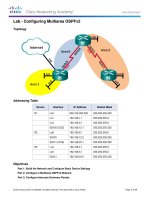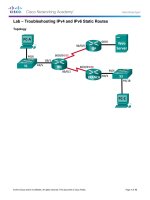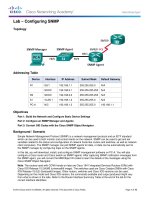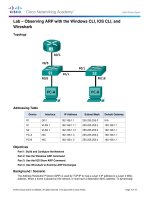Implementing cisco IP telephony and video, part 2 (CIPTV2), 3rd edition kho tài liệu bách khoa
Bạn đang xem bản rút gọn của tài liệu. Xem và tải ngay bản đầy đủ của tài liệu tại đây (36.85 MB, 494 trang )
www.allitebooks.com
Implementing Cisco
IP Telephony and Video,
Part 2 (CIPTV2)
Foundation Learning Guide
(CCNP Collaboration Exam
300-075 CIPTV2)
William Alexander Hannah CCIE #25853
Akhil Behl CCIE #19564
Cisco Press
800 East 96th Street
Indianapolis, IN 46240
www.allitebooks.com
Implementing Cisco IP Telephony and Video,
Part 2 (CIPTV2) Foundation Learning Guide
(CCNP Collaboration Exam 300-075 CIPTV2)
William Alexander Hannah CCIE #25853
Akhil Behl CCIE #19564
Copyright© 2016 Cisco Systems, Inc.
Published by:
Cisco Press
800 East 96th Street
Indianapolis, IN 46240 USA
All rights reserved. No part of this book may be reproduced or transmitted in any form or by any means,
electronic or mechanical, including photocopying, recording, or by any information storage and retrieval
system, without written permission from the publisher, except for the inclusion of brief quotations in a
review.
Printed in the United States of America
First Printing March 2016
Library of Congress Control Number: 2015961048
ISBN-13: 978-1-58714-455-4
ISBN-10: 1-58714-455-7
Warning and Disclaimer
This book is designed to provide information about Cisco Unified IP Telephony and Video administration
and to provide test preparation for the CIPTV Part 2 Version 10.5 exam (CCNP Collaboration CIPTV2
300-075), which is part of the CCNP Collaboration certification. Every effort has been made to make this
book as complete and accurate as possible, but no warranty or fitness is implied.
The information is provided on an “as is” basis. The author, Cisco Press, and Cisco Systems, Inc., shall have
neither liability nor responsibility to any person or entity with respect to any loss or damages arising from
the information contained in this book or from the use of the discs or programs that may accompany it.
The opinions expressed in this book belong to the author and are not necessarily those of
Cisco Systems, Inc.
Trademark Acknowledgments
All terms mentioned in this book that are known to be trademarks or service marks have been appropriately
capitalized. Cisco Press or Cisco Systems, Inc. cannot attest to the accuracy of this information. Use of a
term in this book should not be regarded as affecting the validity of any trademark or service mark.
Special Sales
For information about buying this title in bulk quantities, or for special sales opportunities (which may
include electronic versions; custom cover designs; and content particular to your business, training
goals, marketing focus, or branding interests), please contact our corporate sales department at
or (800) 382-3419.
For government sales inquiries, please contact
For questions about sales outside the U.S., please contact
www.allitebooks.com
iii
Feedback Information
At Cisco Press, our goal is to create in-depth technical books of the highest quality and value. Each book
is crafted with care and precision, undergoing rigorous development that involves the unique expertise
of members from the professional technical community.
Readers’ feedback is a natural continuation of this process. If you have any comments regarding how we
could improve the quality of this book, or otherwise alter it to better suit your needs, you can contact us
through e-mail at Please make sure to include the book title and ISBN in your
message.
We greatly appreciate your assistance.
Publisher: Paul Boger
Associate Publisher: Dave Dusthimer
Business Operation Manager, Cisco Press: Jan Cornelssen
Executive Editor: Brett Bartow
Managing Editor: Sandra Schroeder
Development Editor: Marianne Bartow
Senior Project Editor: Mandie Frank
Copy Editor: Keith Cline
Technical Editors: Steve Foy
Editorial Assistant: Vanessa Evans
Designer: Mark Shirar
Composition: codeMantra
Indexer: Lisa Stumpf
Proofreader: Debbie Williams
www.allitebooks.com
iv
Implementing Cisco IP Telephony and Video, Part 2 (CIPTV2)
About the Authors
William Alexander Hannah, CCIE Collaboration #25853, CCSI #32072, along with
numerous other Cisco Unified Communications and data center specializations, and
VMware certifications, has been an independent IT and telephony consultant, author,
and technical editor for more than 12 years. He has been a technical trainer for more
than 8 years and has taught more than 20 different courses for Cisco. Alex is a Senior
Courseware Developer and Subject Matter Expert for Global Knowledge, designing all
CCNP Collaboration courseware, labs, and infrastructure. He has done a wide array of
IT and telephony consulting for many different companies along the eastern portion of
the United States. A former Senior Architect and Senior Presales Engineer for two Cisco
Gold Partners in the Southern Virginia area, Alex is now the principal owner of Hannah
Technologies LLC, an IT consulting and training firm based in Midlothian, Virginia. Alex
has implemented advanced IP telephony and video installations in his area for more than
12 years. When he is not working, he can be found on a boat, wakeboarding with friends
and family. He can be reached at
Akhil Behl is a Pre-Sales Manager with a leading service provider. His charter involves
an overarching technology portfolio encompassing IoT, collaboration, security,
infrastructure, service management, cloud, and data center. He has 12+ years of
experience working in leadership, advisory, business development, and consulting
positions with various organizations; leading global accounts, driving toward business
innovation and excellence. Previously, he was in a leadership role with Cisco Systems.
Akhil has a Bachelor of Technology degree in electronics and telecommunications from
IP University, India, and a Master’s degree in business administration from Symbiosis
Institute, India. Akhil holds dual CCIE in Collaboration and Security, PMP, ITIL, VCP,
TOGAF, CEH, ISO/IEC 27002, and many other industry certifications.
He has published several research papers in national and international journals, including
IEEE, and has been a speaker at prominent industry forums such as Interop, Enterprise
Connect, Cloud Connect, Cloud Summit, Cisco Sec-Con, IT Expo, Computer Society of
India, Singapore Computer Society, and Cisco Networkers.
Akhil is the author of the following Cisco Press books:
■
CCIE Collaboration Quick Reference
■
Securing Cisco IP Telephony Networks
■
Implementing Cisco IP Telephony and Video (Part 1)
He is a technical editor for Cisco Press and other publications. Akhil can be reached at
www.allitebooks.com
About the Technical Reviewer v
About the Technical Reviewer
Steve Foy, CCSI #96106, is an IT professional and certified CCNP in Collaboration.
Steve is employed by Global Knowledge, and teaches and develops classes and
labs supporting Cisco Collaboration courses, in addition to customized courses for
clients. He has been a Certified Cisco Systems Instructor (CCSI) since 1995. Steve has
experience with Cisco Communications and Collaboration products dating back to
1999, and has been in the IT/data communications industry since 1979. He has worked
for Paradyne and AT&T in previous employments. Steve is co-author of the Cisco Press
publication Cisco Voice over Frame Relay, ATM, and IP (ISBN-10: 1578702275).
Steve is married to Charlene (Chaz), and has four children and five grandchildren.
He lives in the Tampa Bay area of Florida.
www.allitebooks.com
vi
Implementing Cisco IP Telephony and Video, Part 2 (CIPTV2)
Dedications
William Alexander Hannah:
This book is dedicated to several people who have been major influences in my life and
career. First and foremost, I would like to dedicate this book to my father. He blessed
me with the wisdom, drive, and determination to push through obstacles and always
strive to achieve my personal best. Dad, you were a tremendous role model for me
growing up. I hope that as you look down on me from heaven you will know that I have
strived every day to make you proud and earn your respect. To my mother, Sheila, thank
you for being patient with me and showing me unconditional love no matter what the
circumstances. To Kim, I love you and Kendall very much and I am so lucky to have you
both in my life; thank you for supporting me through this process, you are truly the love
of my life. To my sister, Kristol, and brother, Brandon, keep it real. I love you both very
much. To my best friends, Jon and Ricki, thanks for putting up with me and being there
for me to vent and for being a shoulder for support! To all my extended family and
friends, thank you for the support and love during my journey.
Akhil Behl:
I would like to dedicate this book first to my family, my wonderful and beautiful wife,
Kanika, and my lovely children, Shivansh and Shaurya, for their love, patience, sacrifice,
and support while working on this project. They have been very kind and supportive,
as always, during my journey to write yet another book. Moreover, my loving wife
Kanika has been pivotal while writing the book as she reviewed my work and suggested
amendments and improvements.
To my parents, Vijay Behl and Ravi Behl, for their continuous love, encouragement,
guidance, and wisdom. To my brothers, Nikhil Behl and Ankit Behl, who have always
been there to support me in all my endeavors. And I would like to thank God for all his
blessings in my life.
www.allitebooks.com
Acknowledgments vii
Acknowledgments
William Alexander Hannah:
I cannot thank the staff at Cisco Press enough for this opportunity. It has truly been
a lifelong dream to be published in an industry that I have great passion for and love.
Brett and team, thank you for being patient, great motivators, and educators during
my journey. I would like to thank the team at Global Knowledge (Lisa, Lia, Lori, Tyler,
Rick, Pam, and Stuart) for allowing me the platform to train thousands of engineers and
students over the past 8 years. It has truly been the highlight of my career to give back
to individuals and see them achieve their dreams. To my fellow Cisco instructors (Steve,
Ted, Joel, and Dennis), thank you for putting up with me all these years. I would like to
thank my mentors, former employers, and engineering peers: Patrick, David, Alan, Jim,
Adash, Sue, Jose, Duane, Tom, Travis, Greg, Shawn, Will, Larry, Hunter, Tres, Heather,
and Trent. You all provided me a tremendous platform to learn and excel in my craft.
It was truly an honor to work with each of you and learn from the best group of guys
and gals in the world. It is amazing that in a small area like southern Virginia our drive
and passion created more than ten CCIE Collaboration certified engineers. I know our
paths do not cross as often as they should, but I cannot thank you all enough from the
bottom of my heart. Each of you has played a vital role in shaping me and grooming me
for the journey that lies ahead.
Akhil Behl:
I would like to thank the following amazing people and teams for helping me write this
book.
The Cisco Press editorial team: Brett Bartow, the Executive Editor, for seeing the value
and vision in the proposed title and providing me the opportunity to write this book;
and Marianne Bartow, Development Editor, and Ellie Bru, Development Editor, and
Vanessa Evans, Editorial Assistant, for their support and guidance all throughout the
writing of this book. It is my sincere hope to work again with them in the near future.
And my special thanks to everyone else in the Cisco Press production team, for their
support and commitment.
I would like to thank my mentors and my peers who have guided and stood by me all
of these years. Thank you to all my managers and peers from Cisco who have been
supportive of what I wanted to do and helped me achieve it.
www.allitebooks.com
viii
Implementing Cisco IP Telephony and Video, Part 2 (CIPTV2)
Contents at a Glance
Introduction
xxi
Chapter 1
Cisco Collaboration Solution Multisite Deployment Considerations 1
Chapter 2
Understanding Multisite Deployment Solutions 33
Chapter 3
Overview of PSTN and Intersite Connectivity Options 69
Chapter 4
URI-Based Dial Plan for Multisite Deployments 119
Chapter 5
Remote Site Telephony and Branch Redundancy Options 141
Chapter 6
Cisco Collaboration Solution Bandwidth Management 159
Chapter 7
Call Admission Control (CAC) Implementation 183
Chapter 8
Implementing Cisco Device Mobility 209
Chapter 9
Cisco Extension Mobility 241
Chapter 10
Implementing Cisco Unified Mobility 261
Chapter 11
Cisco Video Communication Server and Expressway Deployment 287
Chapter 12
Deploying Users and Endpoints in Cisco VCS Control 311
Chapter 13
Interconnecting Cisco Unified Communications Manager and Cisco Video
Control Server 333
Chapter 14
Cisco Unified Communications Mobile and Remote Access 349
Chapter 15
Cisco Inter-Cluster Lookup Service (ILS) and Global Dial Plan Replication
(GDPR) 377
Chapter 16
Cisco Service Advertisement Framework (SAF) and Call Control
Discovery (CCD) 397
Appendix A
Answers Appendix
Glossary
Index
423
429
441
www.allitebooks.com
Reader Services
Reader Services
Register your copy at www.ciscopress.com/title/ISBN for convenient access to
downloads, updates, and corrections as they become available. To start the registration
process, go to www.ciscopress.com/register and log in or create an account*. Enter the
product ISBN 9781587144554 and click Submit. Once the process is complete, you will
find any available bonus content under Registered Products.
*Be sure to check the box that you would like to hear from us to receive exclusive
discounts on future editions of this product.
www.allitebooks.com
ix
x
Implementing Cisco IP Telephony and Video, Part 2 (CIPTV2)
Contents
Introduction
Chapter 1
xxi
Cisco Collaboration Solution Multisite Deployment Considerations 1
Multisite Deployment Issues Overview 2
Voice and Video Call Quality Issues 5
Bandwidth Challenges 7
Availability Challenges 10
Dial Plan Challenges 12
Overlapping Numbers 12
Nonconsecutive Numbers 13
Variable-Length Numbering 13
Direct Inward Dialing (DID) Ranges and E.164 Addressing 14
Optimized Call Routing 15
Various PSTN Requirements 16
Scalability 17
Fixed Versus Variable-Length Numbering Plans 17
Detection of End of Dialing in Variable-Length Numbering Plans 20
Optimized Call Routing and PSTN Backup 22
PSTN Requirements
23
Issues Caused by Different Methods of PSTN Dialing
24
Dial Plan Scalability Issues 26
NAT and Security Issues 27
Summary 29
References 30
Review Questions 30
Chapter 2
Understanding Multisite Deployment Solutions 33
Multisite Deployment Solution Overview 34
Quality of Service 36
QoS Advantages 37
Overview of Solutions for Bandwidth Challenges 39
Low-Bandwidth Codecs and RTP Header Compression 41
Codec Configuration in CUCM 42
Disabling the Annunciator for Remote Branches 43
Local Versus Remote Conference Bridges 44
Transcoders 44
Contents xi
Leading Practices for Transcoder Design 45
Mixed Conference Bridge 46
Multicast MOH from the Branch Router Flash 47
An Example of Multicast MOH from the Branch Router Flash 49
An Example of Multicast MOH from the Branch Router Flash Cisco IOS
Configuration 51
Alternatives to Multicast MOH from Remote Site Router Flash 52
Preventing Too Many Calls by CUCM Call Admission Control 52
Availability 53
PSTN Backup
MGCP Fallback
55
55
Fallback for IP Phones: SRST, CME SRST, or SIP SRST
56
Using CFUR to Reach Remote Site Cisco IP Phones During WAN
Failure 58
Using CFUR to Reach Users of Unregistered Software IP Phones on
Other Devices 58
AAR and CFNB 59
Mobility Solutions 60
Overview of Dial Plan Solutions 61
NAT and Security Solutions 62
CUBE in Flow-Through Mode 62
Cisco Expressway C and Cisco Expressway E As a Solution to NAT and
Security Issues in a Multisite Environment 63
Summary 64
References 65
Review Questions 65
Chapter 3
Overview of PSTN and Intersite Connectivity Options 69
Overview of Multisite Connection Options 70
CUCM Connection Options Overview 71
Cisco IOS Gateway Protocol Functions Review 72
SIP Trunk Characteristics 73
H.323 Trunk Overview 74
Trunk Implementation Overview 76
Gatekeeper-Controlled ICT and H.225 Trunk Configuration 77
Trunk Types Used by Special Applications 78
Dial Plan Requirements for Multisite Deployments with Distributed Call
Processing 79
Implementing Site Codes for On-Net Calls 81
xii
Implementing Cisco IP Telephony and Video, Part 2 (CIPTV2)
Digit-Manipulation Requirements When Using Access and Site Codes 82
Access and Site Code Requirements for Centralized
Call-Processing Deployments 83
Implementing PSTN Access in Cisco IOS Gateways 84
PSTN Access Example 85
Transformation of Incoming Calls Using ISDN TON 85
ISDN TON Example: Calling Number Transformation of Incoming
Call 87
Implementing Selective PSTN Breakout 88
Configuring IP Phones to Use Local PSTN Gateway 88
Implementing PSTN Backup for On-Net Intersite Calls 90
Digit-Manipulation Requirements for PSTN Backup of On-Net Intersite
Calls 90
Implementing TEHO 92
TEHO Example Without Local Route Groups 93
TEHO Example with Local Route Groups 95
Implementing Globalized Call Routing 96
Globalized Call Routing: Number Formats 98
Normalization of Localized Call Ingress on Gateways 102
Normalization of Localized Call Ingress from Phones 104
Localized Call Egress at Gateways 105
Localized Call Egress at Phones 107
Globalized Call Routing Example: Emergency Dialing 109
Considering Globalized Call Routing Interdependencies 112
Globalized Call Routing and TEHO Advantages 113
Globalized Call Routing TEHO Example 113
Summary 115
References 116
Review Questions 116
Chapter 4
URI-Based Dial Plan for Multisite Deployments 119
URI Dialing Overview 120
URI Endpoint Addressing Overview 123
URI Partitions and Calling Search Spaces 125
URI Call Sources Overview 126
Blended Addressing 127
FQDNs in Directory URIs 128
URI Call Routing 129
Contents xiii
Non-Numeric URI Call Routing Process 132
Numeric URI Call Routing Process 134
Routing URI Calls over SIP Trunks 134
Summary 136
References 137
Review Questions 137
Chapter 5
Remote Site Telephony and Branch Redundancy Options 141
Cisco Unified Communications Manager Express 141
Cisco Business Edition 143
Survivable Remote Site Telephony 144
SRST and E-SRST Configuration 146
SRST IOS Dial Plan 148
CUCM SRST Configuration 149
Multicast Music on Hold in SRST 150
MGCP Fallback 153
Cisco Call Forward Unregistered 154
Summary 156
References 156
Review Questions 156
Chapter 6
Cisco Collaboration Solution Bandwidth Management 159
Bandwidth Management Options 159
Voice and Video Codecs 161
Codec Selection 162
Media Resource Group and Media Resource Group List 166
Multicast Music on Hold 168
Multicast MOH IP Address and Port Considerations 172
Local Conference Bridge 172
Transcoder 176
Summary 179
References 180
Review Questions 180
Chapter 7
Call Admission Control (CAC) Implementation 183
Call Admission Control Characteristics 184
CUCM Call Admission Control 184
Location-Based CAC
185
Location Bandwidth Manager 187
xiv
Implementing Cisco IP Telephony and Video, Part 2 (CIPTV2)
Enhanced Location-Based CAC
189
Resource Reservation Protocol 196
RSVP Configuration 198
RSVP SIP Preconditions 199
Automated Alternate Routing 202
IOS Call Admission Control 204
Local CAC
204
Reservation-Based CAC
Measurement-Based CAC
205
206
Summary 206
References 206
Review Questions 207
Chapter 8
Implementing Cisco Device Mobility 209
Device Roaming Overview 210
Issues with Roaming Devices 210
Using Device Mobility to Solve Roaming Device Issues 212
Device Mobility Overview 213
Device Mobility: Dynamic Phone Configuration Parameters 213
Device Mobility Dynamic Configuration by Location-Dependent
Device Pools 216
Device Mobility Configuration Elements 217
Relationship Between Device Mobility Configuration Elements 218
Device Mobility Operation 220
Device Mobility Operation Flowchart 221
Device Mobility Considerations 224
Review of Line and Device CSSs 225
Device Mobility and CSSs 225
Examples of Different Call-Routing Paths Based on
Device Mobility Groups and Tail-End Hop-Off 226
Device Mobility Interaction with Globalized Call Routing 228
Advantages of Using Local Route Groups and Globalized Call
Routing 229
An Example of Globalized Call Routing That Is Not
Configured with a Different Device Mobility Group 230
An Example of Globalized Call Routing That Is Not
Configured with the Same Device Mobility Group 231
An Example of Globalized Call Routing 232
Contents xv
Device Mobility Configuration 233
Summary 236
References 237
Review Questions 237
Chapter 9
Cisco Extension Mobility 241
Overview of Roaming Between Sites 241
Challenges with Roaming Users 242
CUCM Extension Mobility Overview and Characteristics 243
Extension Mobility: Dynamic Phone Configuration Parameters 244
Extension Mobility with Dynamic Phone Configuration by Device
Profiles 245
CUCM Extension Mobility Operation 245
Cisco Extension Mobility and CSSs 247
CUCM Extension Mobility Device Profile Overview 248
Relationship Between Extension Mobility Configuration Elements 249
Default Device Profile and Feature Safe 251
CUCM Extension Mobility Configuration 252
Summary 257
References 257
Review Questions 257
Chapter 10
Implementing Cisco Unified Mobility 261
Cisco Unified Mobility Overview 262
Mobile Connect and Mobile Voice Access Characteristics 263
Cisco Unified Mobility Call Flow 264
Mobile Connect Call Flow 264
Mobile Voice Access Call Flow 266
Cisco Unified Mobility Implementation Requirements 267
Cisco Unified Mobility Configuration Elements 268
Cisco Unified Mobility MGCP or SCCP Gateway PSTN Access 271
MVA Call Flow with MGCP or SCCP PSTN Gateway Access 272
Calling Search Space Handling in Cisco Unified Mobility 273
CSS Handling in Mobile Voice Access 273
Cisco Unified Mobility Access List Functions 274
Operation of Time-of-Day Access Control 274
Cisco Unified Mobility Configuration 275
Configuring Mobile Connect 275
xvi
Implementing Cisco IP Telephony and Video, Part 2 (CIPTV2)
Configuring Mobile Voice Access 281
Summary 284
References 285
Review Questions 285
Chapter 11
Cisco Video Communication Server and Expressway Deployment 287
Cisco VCS and Expressway Series Overview 288
CUCM with Cisco Expressway Series 289
Cisco VCS Control 289
Cisco VCS-C with Cisco VCS Expressway 290
CUCM and Cisco VCS-C (Combined Solution) 290
Common Terminology for Cisco Video and Legacy Video 290
Cisco VCS and Cisco Expressway Series Deployment Options 292
Cisco VCS Deployment 292
Cisco Expressway Series Deployment 293
CUCM and Cisco VCS-C Interconnection 295
Cisco VCS and Cisco Expressway Series Platforms, Licenses, and
Features 296
Cisco VCS and Cisco Expressway Licensing 297
Cisco VCS and Cisco Expressway Feature Comparison 297
Cisco VCS and Cisco Expressway Clustering 298
Clustering Considerations 299
Cluster Deployment Overview 300
Cisco VCS and Cisco Expressway Series Initial Configuration 301
Summary 306
References 306
Review Questions 307
Chapter 12
Deploying Users and Endpoints in Cisco VCS Control 311
Cisco VCS User Authentication Options 312
LDAP Authentication Configuration Example 313
Endpoint Registration 314
Endpoint Authentication 316
Cisco VCS Authentication Methods 317
Registration Restriction Policy 318
Cisco TMS Provisioning 319
Deploying Cisco Jabber Video for TelePresence 320
Cisco VCS Zones 320
Contents xvii
Local Zone 321
Default Subzone 322
Subzone 323
Traversal Subzone 323
Links 324
Zone Bandwidth Restrictions: Within 325
Zone Bandwidth Restrictions: In&Out 325
Zone Bandwidth Restrictions: Total 326
Pipes 327
Pipe Bandwidth Restrictions 328
Summary 329
References 330
Review Questions 330
Chapter 13
Interconnecting Cisco Unified Communications Manager and Cisco
Video Control Server 333
Cisco Unified Communications Manager and Cisco VCS Interconnection
Overview 334
Call Flow Between CUCM and Cisco VCS 335
Cisco VCS Dial Plan Components 337
Transforms 338
Admin Policy 338
FindMe Feature 339
Search Rules 340
Configuration of CUCM and Cisco VCS Interconnections 340
FindMe Configuration Procedure 341
Summary 344
References 345
Review Questions 345
Chapter 14
Cisco Unified Communications Mobile and Remote Access 349
Cisco Mobile Remote Access Overview 349
Cisco Mobile Remote Access Components 351
Cisco Mobile Remote Access Operation 352
Cisco Mobile Remote Access Firewall Traversal 352
HTTPS Reverse Proxy 354
DNS SRV Setup 354
Registering Remote Jabber Client with CUCM 355
xviii
Implementing Cisco IP Telephony and Video, Part 2 (CIPTV2)
Cisco Unified Communications Mobile and Remote Access
Configuration 357
CUCM Configuration for Cisco Unified Communications MRA 358
IM&P Configuration for Cisco Unified Communications MRA 363
Cisco Expressway (Expressway-C and Expressway-E) Configuration for
Cisco Unified Communications MRA 366
Troubleshooting Cisco MRA
373
Summary 373
References 374
Review Questions 374
Chapter 15
Cisco Inter-Cluster Lookup Service (ILS) and Global Dial Plan
Replication (GDPR) 377
Inter-Cluster Lookup Service Overview 378
ILS Networking Overview 378
ILS Networking Configuration 380
ILS-Based SIP URI Dialing/Routing 381
ILS Calls Via SIP Trunk and Cisco Unified Border Element 383
Directory URI, Enterprise Alternate, and
+E.164 Alternate Number Exchange 385
Global Dial Plan Replication Overview 386
GDPR Configuration 388
Global Dial Plan Catalogs 391
Summary 393
References 393
Review Questions 394
Chapter 16
Cisco Service Advertisement Framework (SAF) and Call Control
Discovery (CCD) 397
Complex Dial Plan Implementation Challenges 397
Cisco Service Advertisement Framework Overview 399
SAF Architecture 399
SAF Characteristics and Operation 402
SAF Clients 402
SAF Client Protocol 403
SAF Forwarders (SAF Forwarding Nodes) 403
SAF Forwarder Protocol 405
SAF Message 406
Contents xix
Call Control Discovery Service Overview 406
Call Control Discovery Schema 408
CCD Characteristics and Operation 408
Use Case 1: Normal Calls via SAF-Enabled Network
to Remote Call Control 410
Use Case 2: Calls via PSTN When the SAF Forwarder Is Down 411
Use Case 3: Normal Calls via SAF-Enabled Network to CUBE 411
SAF and CCD Configuration 412
SAF Client Configuration 412
SAF Forwarder Configuration 417
Summary 419
References 420
Review Questions 420
Appendix A
Answers Appendix
Glossary 429
Index 441
423
xx
Implementing Cisco IP Telephony and Video, Part 2 (CIPTV2)
Command Syntax Conventions
The conventions used to present command syntax in this book are the same conventions
used in the IOS Command Reference. The Command Reference describes these
conventions as follows:
■
Boldface indicates commands and keywords that are entered literally as shown. In
actual configuration examples and output (not general command syntax), boldface
indicates commands that are manually input by the user (such as a show command).
■
Italic indicates arguments for which you supply actual values.
■
Vertical bars (|) separate alternative, mutually exclusive elements.
■
Square brackets ([ ]) indicate an optional element.
■
Braces ({ }) indicate a required choice.
■
Braces within brackets ([{ }]) indicate a required choice within an optional element.
Who Should Read This Book? xxi
Introduction
Professional career certifications have been an important part of the IT industry for
many years and will continue to become more important. Many reasons exist for
these certifications, but the most popularly cited reason is that of credibility and
the knowledge to get the job done. All other considerations held equal, a certified
employee/consultant/job candidate is considered more valuable than one who is
not. CIPTV2 sets the stage with the above objective in mind and helps you learn and
comprehend the topics for the exam and at the same time prepares you for real-world
configuration of Cisco’s audio and video technology.
Goals and Methods
The most important goal of this book is to provide you with knowledge and skills
in Cisco Collaboration solution, with a focus on deploying the Cisco Unified
Communications Manager (CUCM), Cisco TelePresence Video Communications Server
(VCS), Cisco Expressway Series Solution, and associated Cisco Collaboration solution
features. Subsequently, the obvious goal of this book is to help you with the Cisco
IP Telephony and Video (CIPTV) Part 2 exam, which is part of the Cisco Certified
Network Professional Voice (CCNP) Collaboration certification. This book provides
questions at the end of each chapter to reinforce the chapter’s content.
The organization of this book helps you discover the exam topics that you need
to review in more depth, fully understand and remember those details, and test the
knowledge you have retained on those topics. This book does not try to help you pass
by memorization, but to truly learn and understand the topics. The knowledge contained
in this book is vitally important for you to consider yourself a truly skilled Cisco
Collaboration professional. This book helps you pass the Cisco IP Telephony and Video
Part 2 exam by using the following methods:
■
Helps you discover which test topics you have not mastered
■
Provides explanations and information to fill in your knowledge gaps
■
Provides practice exercises on the topics and the testing process via test questions at
the end of each chapter
Who Should Read This Book?
This book is designed as a foundation for Cisco Collaboration and a certificationpreparation book. It provides you with the knowledge required to pass the CCNP Voice
Cisco IP Telephony and Video exam in the CCNP Collaboration exams series.
In today’s world, technology is evolving at a rapid rate and you need to remain
progressive.
xxii
Implementing Cisco IP Telephony and Video, Part 2 (CIPTV2)
How This Book Is Organized
The book covers the following topics:
Chapter 1, “Cisco Collaboration Solution Multisite Deployment Considerations,” sets
the stage for this book by identifying all the relevant challenges and considerations in
multisite deployments requiring Cisco Collaboration solutions.
Chapter 2, “Understanding Multisite Deployment Solutions,” provides insight to the
solutions of challenges identified in Chapter 1 that are described in this book.
Chapter 3, “Overview of PSTN and Intersite Connectivity Options,” provides
an overview of the various mechanisms that the sites in an organization can be
interconnected to in order to reap the benefits of Cisco Collaboration network.
Chapter 4, “URI-Based Dial Plan for Multisite Deployments,” provides insight to SIP
URI for both audio and video calls.
Chapter 5, “Remote Site Telephony and Branch Redundancy Options,” introduces
and explains the various options for deploying remote site telephony solutions and
providing a level of redundancy for remote branches/offices including Cisco Business
Edition, Cisco Unified Communications Manager Express, SRST, and other mechanisms.
Chapter 6, “Cisco Collaboration Solution Bandwidth Management,” describes the
various mechanisms to manage bandwidth, which is one of the most expensive and
precious resources in a Cisco Collaboration solution.
Chapter 7, “Call Admission Control (CAC) Implementation,” provides insight to
bandwidth control using various mechanisms, including CAC, E-LCAC, RSVP, to ensure
that the call quality is maintained and calls are served as per the organization’s policies.
Chapter 8, “Implementing Cisco Device Mobility,” provides insight to deployment of
Cisco’s device mobility solution to support roaming users.
Chapter 9, “Cisco Extension Mobility,” explains the concept and implementation of hot
desking or hoteling in a Cisco Collaboration environment.
Chapter 10, “Implementing Cisco Unified Mobility,” discusses the concept and
implementation of Cisco’s Mobility solution components (SNR and MVA), which are
features that are most commonly used when an organization has a mobile or remote
workforce.
Chapter 11, “Cisco Video Communication Server and Expressway Deployment,”
describes the deployment models pertinent to Cisco VCS and Expressway solution.
Cisco VCS and Expressway solutions are state-of-the-art solutions that offer video,
audio, and conferencing to enterprise users and mobile users.
Chapter 12, “Deploying Users and Endpoints in Cisco VCS Control,” expands on the
previous chapter and discusses the deployment of users and endpoints on a Cisco VCS
solution.
How This Book Is Organized xxiii
Chapter 13, “Interconnecting Cisco Unified Communications Manager and Cisco Video
Control Server,” discusses the integration of Cisco VCS with CUCM and explains the
leading practices of performing such integration.
Chapter 14, “Cisco Unified Communications Mobile and Remote Access,” describes
the concept and configuration of the Cisco MRA feature for remote users leveraging
Jabber client on the go for voice, video, presence, and other collaboration features and
functions.
Chapter 15, “Cisco Inter-Cluster Lookup Service (ILS) and Global Dial Plan Replication
(GDPR),” dives deep into concepts and deployment of automated dial plan replication
and leveraging URI-based dial plan across multiple clusters in an organization.
Chapter 16, “Cisco Service Advertisement Framework (SAF) and Call Control Discovery
(CCD),” explains the use of Cisco’s Service Advertisement Framework and associated
services (such as Call Control Discovery) for automated replication of dial plans using
the underlying network in a Cisco Collaboration solution.
Answers Appendix allows you to check the validity of your answers at the end of each
chapter as you review the questions.
This page intentionally left blank









